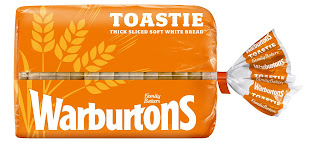Supply chains and location - trade, labelling, netzero - an example and a wider analogy
Despite our best efforts the kids have grown up with a certain white bread, you know the one, in the orange (or blue) waxed packaging. Yep,
(c) Warburtons
While supply chains have always been an interest, bread ingredients wasn't shall we say prominent. Warburton's decision to switch suppliers is a handy exemplar not just for the global nature of trade but for the different regulatory environments and production standards that go with that. The switch doesn't come until 2022 with the new supplier being US Frontier Agriculture and you would think that they will seek to protect the brand - you get those kids early they stay for life.
At this stage it is unclear from where Frontier will source the wheat for the flour as they do have a large UK operation including in Northumberland. Nevertheless this highlights the challenges global supply chains represent to industry (think food processing, for schools, hospitals, canning etc), retail (think bread/bakery buyers across all major supermarkets in this instance) and the citizen/consumer.
The forthcoming trade negotiations with the US will have a large agriculture component. The focus has mostly been on chlorinated chicken and hormone drenched beef but beyond that noise the real arguments are likely to be found in labelling of raw and processed food (and phytosanitary inspection regimes), with the US arguing that any packaging information that informs the consumer as the source of the ingredients would be prejudicial. Which brings us back to humble flour.
Or rather to pesticide residues, bleach (typically benzoyl peroxide) and what the US FDA term "food defects" - acceptable levels of food contamination from sources such as maggots, thrips (a pest but also a vector for plant diseases), insect fragments, "foreign matter", mould, rodent hairs, and insect and mammalian faeces. The handbook reveals for wheat flour, permitted "insect filth" of an average of 75 or more insect fragments per 50 grams and permits "rodent filth" to a level of an average of 1 or more rodent hairs per 50 grams, describing the significance as "aesthetic". This is a fuller FDA list:
You can eat a lot of insects - take coffee under FDA - the average US coffee drinker could technically take in almost 140,000 insect fragments (protein!) a year!
Anyway, the Federation of Bakers estimates that UK flour mills process 5 million tonnes of wheat each year, 85% of which is home grown. Some is already imported from Canada, the USA, France and Germany. All of it carrying a bulk transport pollution burden - global shipping accounting for c.3% of GHGs with bulk carriers some 19% of that. Change is coming to heavy marine with touted efficiency savings up to 30% though this is early days for these technologies.
Food supply chains are investing in IoT and increasingly in track and trace blockchain/distributed ledger technologies to underpin authenticity and regulatory compliance. Commodities traders depend on satellite derived crop health indices among others. They operate on a global basis with FOB pricing reflecting fluctuations in supply and demand at scale, less the externalities, frictions and risks of any specific delivery to a bread factory in Yorkshire. With #netzero rightly such a prominent factor in economic strategy and industrial policy there is good reason for consumer and supermarket buyer alike to consider and/or be alerted to #foodmiles and associated emissions - grain will have travelled 7-8000km from the US great plains to processing plants in the UK. [emissions from #landusechange and, for meat, on-farm emissions are separate and greater ag-related GHG contributions].
Location provides the unifying frame for all these different parts of the supply chain, from the field to the factory to the retail floor. Climate, soil, elevation, slope, aspect inform crop selection and rotation, seed type, while weather and crop health informs increasingly precision use of pesticides/herbicides/fungicides, harvest, yield, moisture and energy for drying. Add in all those transport stages. It comes as no surprise that wine from different vineyards on the same estate have different characteristics and that this location provenance is key for the winery in producing distinctive blends from the same grapes. Equally the use of IoT in mining is providing supply chain visibility literally from the rock face. The point being that producers and processors and brands can and do know where their inputs come from and can contract, process and label accordingly.
So, to the wider analogy. Internet platforms are not currently classed as publishers. Does that mean supermarkets are not, other than for own brand, producers, but merely, and literally, the shop window for consumers? The platforms are under pressure, should the supermarkets be also? If, and it remains an if at this stage, Warburtons start using flour from the US subject to the permissions of the FDA, should they label accordingly? Will we know, how would consumers demand appropriate labelling (enabling intelligent choice), would or could processors and packagers label, would buyers, who determine what products feature on our supermarket shelves, act as health and welfare advocates for their customers and cease to stock items that don't meet certain criteria?
Literally the world has been shifting while I've been drafting - Aldi and Waitrose moved on to the front foot on chlorinated chicken/hormone injected beef labelling first, Coop, M&S have followed. Where ingredients are from, what standards apply there, and how they got to the supermarket shelf are becoming important factors for the supermarket buyer and the consumer.



Comments
Post a Comment
Thank you for taking the time to ponder my musings and for any contribution you make. Although comments appear immediately (i.e. unmoderated) I will remove (or if possible) edit offensive comments.